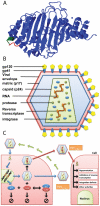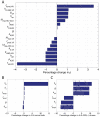Multi-scale modeling of HIV infection in vitro and APOBEC3G-based anti-retroviral therapy
- PMID: 22346743
- PMCID: PMC3276540
- DOI: 10.1371/journal.pcbi.1002371
Multi-scale modeling of HIV infection in vitro and APOBEC3G-based anti-retroviral therapy
Abstract
The human APOBEC3G is an innate restriction factor that, in the absence of Vif, restricts HIV-1 replication by inducing excessive deamination of cytidine residues in nascent reverse transcripts and inhibiting reverse transcription and integration. To shed light on impact of A3G-Vif interactions on HIV replication, we developed a multi-scale computational system consisting of intracellular (single-cell), cellular and extracellular (multicellular) events by using ordinary differential equations. The single-cell model describes molecular-level events within individual cells (such as production and degradation of host and viral proteins, and assembly and release of new virions), whereas the multicellular model describes the viral dynamics and multiple cycles of infection within a population of cells. We estimated the model parameters either directly from previously published experimental data or by running simulations to find the optimum values. We validated our integrated model by reproducing the results of in vitro T cell culture experiments. Crucially, both downstream effects of A3G (hypermutation and reduction of viral burst size) were necessary to replicate the experimental results in silico. We also used the model to study anti-HIV capability of several possible therapeutic strategies including: an antibody to Vif; upregulation of A3G; and mutated forms of A3G. According to our simulations, A3G with a mutated Vif binding site is predicted to be significantly more effective than other molecules at the same dose. Ultimately, we performed sensitivity analysis to identify important model parameters. The results showed that the timing of particle formation and virus release had the highest impacts on HIV replication. The model also predicted that the degradation of A3G by Vif is not a crucial step in HIV pathogenesis.
Conflict of interest statement
The authors have declared that no competing interests exist.
Figures











Similar articles
-
Identification of a novel HIV-1 inhibitor targeting Vif-dependent degradation of human APOBEC3G protein.J Biol Chem. 2015 Apr 17;290(16):10504-17. doi: 10.1074/jbc.M114.626903. Epub 2015 Feb 27. J Biol Chem. 2015. PMID: 25724652 Free PMC article.
-
Mechanism of Enhanced HIV Restriction by Virion Coencapsidated Cytidine Deaminases APOBEC3F and APOBEC3G.J Virol. 2017 Jan 18;91(3):e02230-16. doi: 10.1128/JVI.02230-16. Print 2017 Feb 1. J Virol. 2017. PMID: 27881650 Free PMC article.
-
APOBEC3G and APOBEC3F Act in Concert To Extinguish HIV-1 Replication.J Virol. 2016 Apr 14;90(9):4681-4695. doi: 10.1128/JVI.03275-15. Print 2016 May. J Virol. 2016. PMID: 26912618 Free PMC article.
-
Various strategies for developing APOBEC3G protectors to circumvent human immunodeficiency virus type 1.Eur J Med Chem. 2023 Mar 15;250:115188. doi: 10.1016/j.ejmech.2023.115188. Epub 2023 Feb 6. Eur J Med Chem. 2023. PMID: 36773550 Review.
-
[Advances in the study of molecular mechanism of APOBEC3G anti-HIV-1].Yao Xue Xue Bao. 2008 Jul;43(7):678-82. Yao Xue Xue Bao. 2008. PMID: 18819469 Review. Chinese.
Cited by
-
Combinatorial anti-HIV gene therapy: using a multipronged approach to reach beyond HAART.Gene Ther. 2013 Jul;20(7):695-702. doi: 10.1038/gt.2012.98. Epub 2013 Jan 31. Gene Ther. 2013. PMID: 23364313 Free PMC article. Review.
-
Multi-scale immunoepidemiological modeling of within-host and between-host HIV dynamics: systematic review of mathematical models.PeerJ. 2017 Sep 28;5:e3877. doi: 10.7717/peerj.3877. eCollection 2017. PeerJ. 2017. PMID: 28970973 Free PMC article.
-
Mechanistic Models Predict Efficacy of CCR5-Deficient Stem Cell Transplants in HIV Patient Populations.CPT Pharmacometrics Syst Pharmacol. 2016 Feb;5(2):82-90. doi: 10.1002/psp4.12059. Epub 2016 Feb 16. CPT Pharmacometrics Syst Pharmacol. 2016. PMID: 26933519 Free PMC article.
-
APOBEC3G-Augmented Stem Cell Therapy to Modulate HIV Replication: A Computational Study.PLoS One. 2013 May 22;8(5):e63984. doi: 10.1371/journal.pone.0063984. Print 2013. PLoS One. 2013. PMID: 23724012 Free PMC article.
-
Incorporating Intracellular Processes in Virus Dynamics Models.Microorganisms. 2024 Apr 30;12(5):900. doi: 10.3390/microorganisms12050900. Microorganisms. 2024. PMID: 38792730 Free PMC article. Review.
References
-
- Chiu YL, Greene WC. The APOBEC3 cytidine deaminases: an innate defensive network opposing exogenous retroviruses and endogenous retroelements. Annu Rev Immunol. 2008;26:317–353. - PubMed
Publication types
MeSH terms
Substances
LinkOut - more resources
Full Text Sources
Medical

